If you look at the long list of ingredients in many foods and supplements, you may notice sea salt as an added ingredient. And you may even feel it’s great for health benefits. But is that really the case?
However, MOST sea salts don’t offer as much in terms of health benefits for those with thyroid disease, because of their high iodine content. When you are getting too much iodine, it can slow down your thyroid. As I talk about in my book, The Thyroid Reset Diet, regulating iodine intake helps your thyroid (and overall body) function better.
So can you have any sea salt if you’re working to improve your thyroid health?
How much is too much?
Are there safer salt alternatives?
The short answer is that sea salt is safe in certain situations. Small amounts are fundamental. Or you can look for the non-iodized versions. (Continue reading to see the best options).
However, the salt also hides in other foods and supplements. So, there are also scenarios where cutting sea salt from your diet is in your best interest to keep your iodine intake low.
Does Sea Salt Have Iodine In High Amounts?
Sea salt and table salt offer roughly the same nutritional value, even though sea salt is often touted as the healthier option. Both have similar amounts of sodium in them. However, sea salt can be a high source of iodine.
We need iodine.
Low amounts of iodine can lead to impaired thyroid function1. But iodine as an added ingredient is often counter-productive.
The issue with sea salt is that many people use it more when they cook to achieve the same flavor level as table salt, making it easy to push past the recommended limit.
Salt, as with most things in life, is better in small amounts. The healthiest course of action is to maintain a balance.
The first trick to achieve balance and boost your thyroid health is to watch your iodine levels. Reducing iodine levels allows your body to function better with thyroid hormones. Maintaining low levels of iodine can also clear out the excess and give your body the time it needs to heal.
The Main Types of Salt In Stores
When you go to the store for the type of salt you add to your food, you probably notice tons of different kinds. The three primary salts you’re most likely to see in stores include:
- Iodized table salt: This inexpensive salt is commonly available. It’s mined from the land, and iodine is added to it later, which started as a public health initiative for people who need more iodine in their diets.
- Kosher salt: Like table salt, kosher salt comes from the land. But it’s lighter, less salty tasting, and excellent for adding flavor when you’re cooking meals.
- Sea salt: A salt type from evaporated seawater, sea salt is commonly used for seasoning and preserving food. The flavor varies from other salt types based on where the crystals formed2.
There are also countless choices, like fine or coarse, and pricier gourmet salts.
As I share in my book, The Thyroid Reset Diet, the best options include kosher salt, canning salt, or Celtic brand light gray sea salt.
Avoid unbranded sea salt, pink Himalayan salt, and iodized salt. I’ll explain why in more detail below.
Unbranded Sea Salt
Unbranded sea salt is the purest form available on the market. It’s free of additives and toxins. Sometimes companies tout unbranded sea salt as unrefined, coarse crystal flakes or as the organic choice.
However, unbranded sea salt is not ideal for your daily salt. The flakes may be larger, but the sea salt contains as much sodium by volume as any other salt.
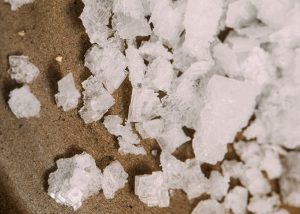
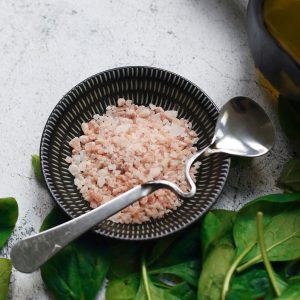
Himalayan Pink Salt
You’ve probably heard health claims about Pink Himalayan sea salt in recent years. It’s naturally pink and mined near the Himalayas in Pakistan. Pink Himalayan is like sea salt, but it has about twice the iodine amount as traditional iodine salt.
People say Himalayan pink salt benefits come from the minerals, which provide a health boost. Non-dietary uses claim to remove air pollutants or improve skin and respiratory issues.
However, a study that analyzed the minerals in varying salt types shows that pink Himalayan salt does contain more calcium, potassium, magnesium, and iron4. The amounts are tiny and unlikely to provide many health benefits.
Safe Brands of Sea Salt
Morton salt is one of the most trusted brands of table salt in America. Be sure to get non-iodized salt if you use that brand. But if you still want to look for safe sea salt, you can try a few different brands.
The safe brands of sea salt to use for cooking include:
- Celtic: This brand of light gray sea salt comes in coarse or fine ground options, both negligible in iodine.
- Maldon’s: An English finishing sea salt that’s negligible in iodine.
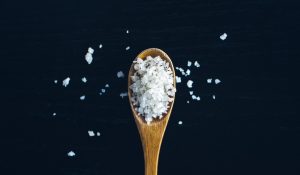
People say Celtic sea salt benefits come from the minerals, but like Himalayan salt, the levels are also not high enough to impact your health.
Celtic sea salt is the better choice because it has minuscule amounts of sodium when compared to other salts. It also holds onto more calcium and magnesium.
While these trace amounts won’t boost your health, switching from a table salt that’s high in sodium could help if you have high blood pressure or heart troubles. Low amounts of sodium also benefit your thyroid.
Sea Salt As The Main Salt Vs. A Secondary Ingredient
The most important thing to understand about salt is that the salt you add to your meal at the dinner table is not the most significant contributor to your daily sodium and iodine intake.
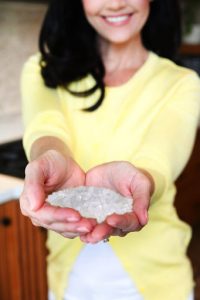
- Food
- Supplements
- Medication
- Cosmetics
Although the added ingredient is not typically in high amounts, it can add up throughout your day and cause your thyroid problems later.
The CDC says more than 70% of the sodium Americans consume per day comes from eating in restaurants and processed foods5. But iodine also hides in supplements, medications, condiments, etc.
It’s easy to see how these invisible sources can combine to cause a huge problem, right?
Sometimes the ingredient hides in small amounts. Others hide iodine by labeling it synthetic folic acid. However, product labels don’t always claim the correct amount of iodine either.
Why? Poorly controlled manufacturing processes.
Thyroid medications often contain iodine, which is another crucial reason to keep an eye on your total iodine intake. The iodine in your medications binds with hormones, so reducing your iodine levels from other sources is the only way to help your thyroid heal.
How Much Salt Is Too Much?
Most people use about a tablespoon of salt per day. But if you’re not closely paying attention to the hidden salt in your foods and supplements, your daily intake can quickly grow.
No matter what type of salt you prefer, consume it in moderation. The CDC recommends Americans have less than 2,300 milligrams (mg) of sodium per day6.
But for a healthy eating pattern that you don’t need to think about, shoot for less than 500 mg of sodium per serving. More than this amount can become negligible.
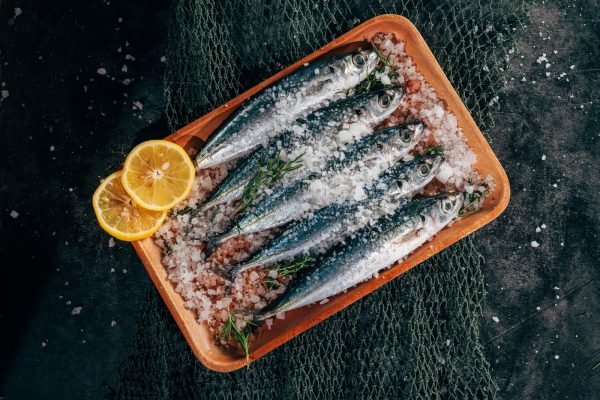
However, limiting iodine isn’t only for those with thyroid disease already. The American Thyroid Association says more than 1,100 mcg of iodine per day can trigger thyroid disease in nearly anyone7.
So, less is more when we’re dealing with iodine.
How To Regulate Iodine & Heal Your Thyroid
Regulating iodine helps your thyroid work better, helping with weight loss and overall health. It also allows your body to work better with thyroid hormones. With low enough amounts of iodine, your body begins to heal.
But you don’t have to cut salt from your diet entirely to gain these benefits.
Limit salt in your food, sure. You can also cut down on your iodine intake by limiting the TYPE of salt you consume as an added ingredient.
How To Regulate Iodine & Heal Your Thyroid
Regulating iodine helps your thyroid work better, helping with weight loss and overall health. It also allows your body to work better with thyroid hormones. With low enough amounts of iodine, your body begins to heal.
But you don’t have to cut salt from your diet entirely to gain these benefits.
Limit salt in your food, sure. You can also cut down on your iodine intake by limiting the TYPE of salt you consume as an added ingredient.
Look for an iodine-free multivitamin with selenium, zinc, and folate. Our Daily Reset Pack is a thyroid-friendly multi with a full spectrum of the nutrients needed by someone with thyroid disease. (Read: A Deep Dive on Selenium)
Instead, focus on supplements with iodine testing from independent sources and check their test results.
Boost Thyroid Health With A Daily Reset Shake
Another excellent option to help your thyroid is to reset. The reset phase helps get rid of excess iodine. The case studies I include in The Thyroid Reset Diet show that three months of the reset phase can reverse thyroid disease and heal your body.
One of the crucial ways to reset your thyroid during this time is to switch to kosher salt or Celtic sea salt. What you consume during this time is vital.
The Benefits Of Salt
People consider sea salt superior to table salt because it’s minimally processed, allowing it to hold onto trace amounts of nutrients and minerals. Sea salt gains nutrients like magnesium, iron, potassium, sodium, and calcium from the seawater.
Because it comes from the sea, sea salt holds onto many nutrients that you don’t see in other salts. For example, the nutrients are removed from table salt. Many people think this makes sea salt the better, healthier choice.
But the minerals in sea salt could also cause problems for your thyroid. Some ingredients appear in much higher amounts than are safe for daily consumption.
Magnesium (Mg)
Magnesium is the most prominent nutrient in sea salt. You may get around 20 to 30 mg of magnesium from a teaspoon of sea salt, which isn’t a considerable amount. We need between 250 to 350 mg per day, so it’s only about a 10th of your recommended intake.
Iron (Fe)
Iron is the next most prevalent nutrient. A teaspoon of sea salt has 0.2 mg of iron. Our bodies need between 10 and 18 mg of iron per day, so you would need to consume a lethal dose of salt (around 180 teaspoons) to reach the iron required to make a real difference.
Potassium (K)
Many sea salt brands claim to offer high levels of potassium. However, the amounts are still too small to provide anything more than other trace nutrients. A speck of spinach has more potassium value than sea salt, so you’re better off getting your potassium intake from food.
Zinc (Zn)
The exact amount of sea salt also has a tiny amount of zinc. However, the 0.01 mg of zinc is nowhere close to the 10 mg we need each day.
Sodium (Na)
Sea salt has more iodine than table salt, but it has much higher amounts of sodium8,9. Sea salt is mainly composed of sodium chloride, which regulates blood pressure and fluid balance.
However, the sodium in sea salt is not great for your health. Excessive sodium in your diet puts you at an increased risk of heart disease and high blood pressure10.
Even the main ingredient in salt, sodium, is not enough to help nutrient deficiencies. Sea salt contains the same sodium levels as other salt types, which is also in small amounts.
Half Your Salt And Eat It Too
Sea salt is a common way to add flavor to foods. However, the trend is not as healthy as it seems.
While getting enough sodium is crucial for digestion, hydration, and fluid balance, sea salt isn’t the best way to meet your daily sodium needs. If you’re on medication for your thyroid, it could even be detrimental to your health.
Switching to a low-iodine salt is a great substitute, but you should also watch out for the iodine already in things. Many unprocessed foods have sea salt as an added ingredient, mainly condiments.
Watch the ingredient labels in your supplements, medications, vitamins, and cosmetics as well.
Sea salt comes with tons of uses, but it’s not a healthy alternative to table salt. You don’t have to skip the salt entirely or always cut back on your usage.
Just make sure you’re using an iodine-free salt and supplements. Try the Celtic brand of light gray sea salt, or go with kosher salt for cooking. Use an iodine-free multivitamin, and try my Daily Reset Shake to maintain your healthy state.
And if you need any help, I’m here to ask.

Try The Thyroid Quiz Today
Give the Thyroid Quiz a try Click Here. It can really give you a great sense of where you stand, and some of the steps you can take. I hope you’ll give it a try right now.
Resources
2 – https://www.ncbi.nlm.nih.gov/pmc/articles/PMC5971493/
3 – Tazebay UH, Wapnir IL, Levy O, Dohan O, Zuckier LS, Zhao QH, Deng HF, Amenta PS, Fineberg S, Pestell RG, Carrasco N. The mammary gland iodide transporter is expressed during lactation and in breast cancer. Nature medicine. 2000;6:871–878.
4 – Tazebay UH, Wapnir IL, Levy O, Dohan O, Zuckier LS, Zhao QH, Deng HF, Amenta PS, Fineberg S, Pestell RG, Carrasco N. The mammary gland iodide transporter is expressed during lactation and in breast cancer. Nature medicine. 2000;6:871–878.
5 – He S, Wang B, Lu X, et al. Iodine stimulates estrogen receptor singling and its systemic level is increased in surgical patients due to topical absorption. Oncotarget. 2017;9(1):375-384. Published 2017 Sep 4. doi:10.18632/oncotarget.20633
6 – He S, Wang B, Lu X, et al. Iodine stimulates estrogen receptor singling and its systemic level is increased in surgical patients due to topical absorption. Oncotarget. 2017;9(1):375-384. Published 2017 Sep 4. doi:10.18632/oncotarget.20633
7 – He S, Wang B, Lu X, et al. Iodine stimulates estrogen receptor singling and its systemic level is increased in surgical patients due to topical absorption. Oncotarget. 2017;9(1):375-384. Published 2017 Sep 4. doi:10.18632/oncotarget.20633
8 – Tazebay UH, Wapnir IL, Levy O, Dohan O, Zuckier LS, Zhao QH, Deng HF, Amenta PS, Fineberg S, Pestell RG, Carrasco N. The mammary gland iodide transporter is expressed during lactation and in breast cancer. Nature medicine. 2000;6:871–878.
9 – Tazebay UH, Wapnir IL, Levy O, Dohan O, Zuckier LS, Zhao QH, Deng HF, Amenta PS, Fineberg S, Pestell RG, Carrasco N. The mammary gland iodide transporter is expressed during lactation and in breast cancer. Nature medicine. 2000;6:871–878.
10 – Tazebay UH, Wapnir IL, Levy O, Dohan O, Zuckier LS, Zhao QH, Deng HF, Amenta PS, Fineberg S, Pestell RG, Carrasco N. The mammary gland iodide transporter is expressed during lactation and in breast cancer. Nature medicine. 2000;6:871–878.

P.S. Whenever you are ready, here is how I can help you now:
1. Schedule a complimentary consultation with one of my team of naturopathic doctors. This is a great starting point for assessing your unique health needs and treatment options.
2. Download and use my Favorite Recipes Cookbook Here
3. Check out my podcast Medical Myths, Legends, and Fairytales Here
Dr. Alan Glen Christianson (Dr. C) is a Naturopathic Endocrinologist and the author of The NY Times bestselling Adrenal Reset Diet, The Metabolism Reset Diet and The Thyroid Reset Diet.
Dr. C’s gift for figuring out what really works has helped hundreds of thousands of people reverse thyroid disease, lose weight, diabetes, and regain energy. Learn more about the surprising story that started his quest.




